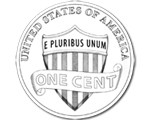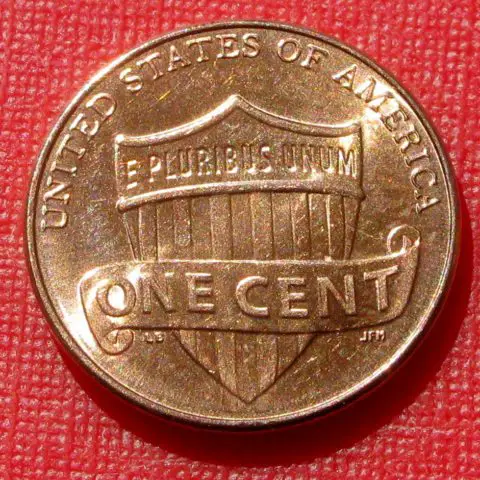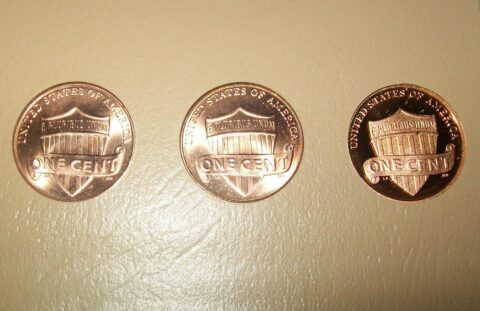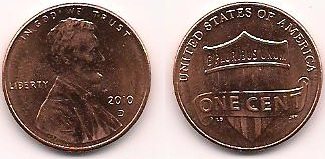In 2010, a new penny entered into circulation.
The Lincoln cent, which turned 101 years old that year, bears a shield on the reverse.
It’s the 3rd long-term reverse design in the Lincoln cent series.
How The Shield Penny Came To Be
The Shield cent is 1 of 18 original concepts that U.S. Mint artists created for the new United States coin..
 Several proposed design topics for the new penny were considered, including:
Several proposed design topics for the new penny were considered, including:
- The U.S. Capitol
- Wheat Stalks
- Eagles
- American Flag
The design proposals were released to the public in May 2009.
The final choice for the reverse design of the 2010 Lincoln cent ultimately lied in the hands of the U.S. Secretary of the Treasury.
On November 12, 2009 (the same day the United States Mint released the last of the 4 Lincoln Bicentennial cent designs into circulation), the U.S. Mint unveiled the new penny design for 2010 and beyond.
In January of 2010, the new penny was officially released into circulation and in coin sets made by the U.S. Mint.
Facts About The New Penny
Every coin has some interesting and fun info and trivia behind it.
Here are a few things you might not know about the new penny:
- Lyndall Bass is the designer of the reverse on the new Lincoln cent.
- Josesph Menna is the sculptor of the new penny.
- The union shield design on the coin is seen on frescoes throughout the U.S. Capitol Building.
- The union shield design is highly representative of our nation’s oneness in the decades since the end of the Civil War.
- There are 13 vertical stripes on the shield — which represent the original 13 states.
- There is a horizontal bar at the top — which represents the federal government.
- “E PLURIBUS UNUM” is inscribed on a banner across the shield.
- The metal composition of the Lincoln cent in 2010 (and in later years) is copper-plated zinc, which has been the penny’s composition for circulation strikes since 1982.
Design Of The New Shield Penny
Lincoln’s portrait remains on the obverse (heads side) of the penny — it looks just as it has since it was first placed on the U.S. penny in 1909.
It is only the obverse (tails side) of the new penny that was changed in 2010.
The shield design on the new one-cent coin is, in many ways, a throwback that hearkens to the days of the Two Cent piece and Shield nickel — both of which were coins made in the U.S. during the mid-1800s. A shield is the central element on both of those coins.
The design also reflects the unity that President Abraham Lincoln helped re-establish when he helped guide the United States from the division between the North and South that erupted during the Civil War era.
The shield represents President Lincoln’s ability to maintain the Union even during the Civil War, which threatened to rip our nation in two.
Controversy About The New Penny Design
There was a bit of controversy regarding the proposed designs for the 2010 Lincoln cents.
It involves the wheat stalk design LP-18 (which is the last design seen in the very first link above).
The Commission of Fine Arts had actually chosen the wheat stalk design as their favorite. However, a major issue arose upon further investigation. The wheat stalk design is strikingly similar to Germany’s pfennig (a type of German coin) design from the 1920s and 1930s!
Take a look and see for yourself.
How The Lincoln Cent Has Changed
The Lincoln cent has a long history.
First minted in 1909, the Lincoln cent replaced the Indian Head cent. The original Lincoln penny had a design on the reverse showing 2 wheat stalks. The wheat ears design was minted from 1909 through 1958.
Wheat pennies have long been a favorite of coin collectors!
In 1959, the 150th anniversary of Lincoln’s birth prompted the U.S. Mint to adopt the Lincoln Memorial reverse design. Designed by Frank Gasparro, the Lincoln Memorial design lasted on the Lincoln cent until 2008.
In 2009, the U.S. Mint released pennies with 4 special designs on the reverse side — commemorating the bicentennial (200th anniversary) of Lincoln’s birth.
The 4 designs depict the following:
- Lincoln’s birthplace, a Kentucky log cabin
- Lincoln’s formative years, when he was a log splitter and voracious reader
- Lincoln’s professional life in Illinois, where he was a senator
- Lincoln’s presidency, during which the Civil War took place and ended while Lincoln was president from 1861 to 1865
In 2010, the U.S. Mint released the new Lincoln Shield penny — it replaced the 50-year-old Lincoln Memorial design with the union shield.
The Future Of The Lincoln Penny
The new penny’s 2010 design will most likely remain unchanged for many, many years to come — or until the penny is removed from circulation for good.
There has actually been some controversy on that issue (whether or not to even keep the one cent coin around) — because it’s becoming very costly to keep minting it every year.
Did you know that it costs 1.82 cents to make every U.S. penny today?
Current Shield Penny Values
Wondering what your Lincoln Shield pennies are worth?
Here’s a look at the latest values for Lincoln Shield cents made since 2010:
- 2010 — 10 cents
- 2010-D — 10 cents
- 2010-S Proof — $3
- 2011 — 10 cents
- 2011-D — 10 cents
- 2011-S Proof — $3
- 2012 — 10 cents
- 2012-D — 10 cents
- 2012-S Proof — $3
- 2013 — 10 cents
- 2013-D — 10 cents
- 2013-S Proof — $3
- 2014 — 10 cents
- 2014-D — 10 cents
- 2014-S Proof — $3
- 2015 — 10 cents
- 2015-D — 10 cents
- 2015-S Proof — $3
- 2016 — 10 cents
- 2016-D — 10 cents
- 2016-S — $3
- 2017-P — 10 cents
- 2017-D — 10 cents
- 2017-S — $3
- 2018 — 10 cents
- 2018-D — 10 cents
- 2018-S Proof — $3
- 2019 — 10 cents
- 2019-D — 10 cents
- 2019-W — $10
- 2019-S Proof — $3
- 2019-W Proof — $10
- 2019-W Reverse Proof — $10
- 2020 — 10 cents
- 2020-D — 10 cents
- 2020-S Proof — $4
*Prices are for coins in uncirculated condition unless otherwise specified as “proof”. Unless an error or special variety, circulated Shield pennies (the types found in circulation) are worth face value.
3 Tips For Collecting The Shield Penny
Lincoln Shield cents are extremely common, and they are gradually overtaking the presence of Lincoln Memorial cents in circulation.
Here are 3 ways to help make your goals of collecting Lincoln Shield pennies even easier and more fun:
- Look for varieties. There have been several reports of Lincoln Shield penny errors and varieties — including minor doubled dies, die cracks, and off-center errors. These are worth a small premium over regular values.
- Check coin rolls for valuable uncirculated pieces. The earlier Lincoln Shield cents have been in circulation for years now and they’re showing it. Many are worn and discolored due to environmental damage. However, you can find nice uncirculated examples from all different years in bank rolls.
- Assemble a date-and-mintmark set while Shield penny values are still low. If you really want to build a nice Lincoln Shield cent collection, start buying all the different uncirculated and proof issues going back to 2010. Prices are still relatively low for Lincoln Shield pennies, and if you wish to build a complete set this is the time to do it — before prices possibly go up in the future.








